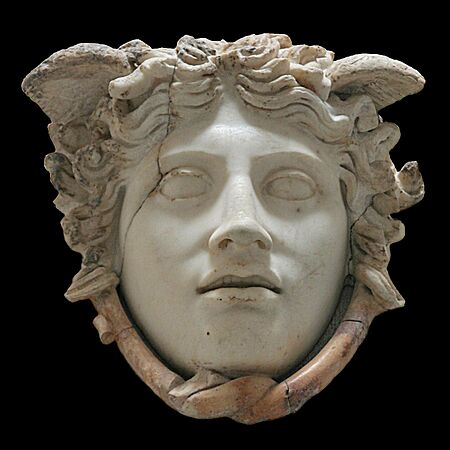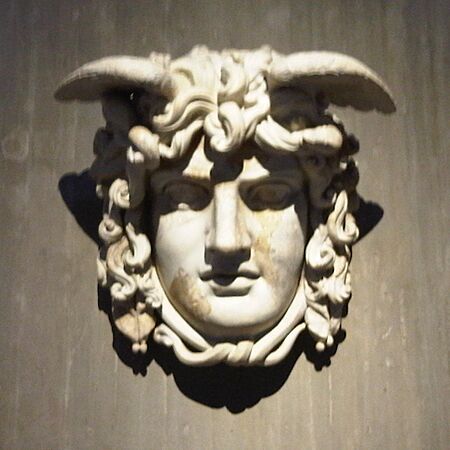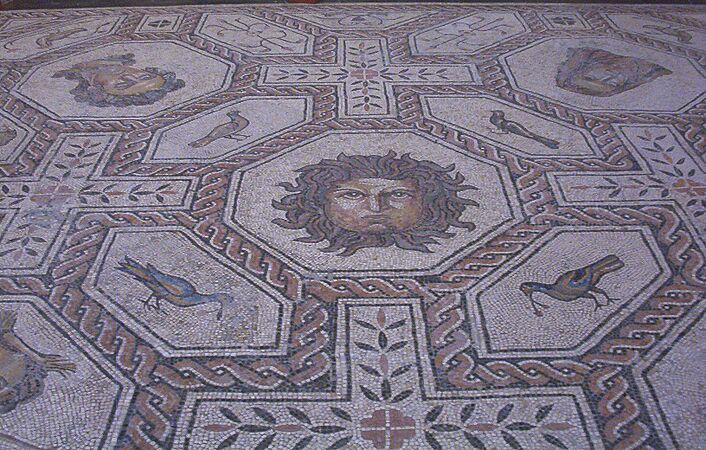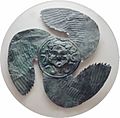Gorgoneion facts for kids
The Gorgoneion (pronounced Gor-go-NEE-on) was a special magic pendant in Ancient Greece. It showed the head of a Gorgon, like the famous Medusa. People believed it could protect them from evil or bad luck. This kind of protective magic is called apotropaism.
The Gorgoneion was often linked to the gods Zeus and Athena. Both gods were said to wear it. It was also a popular symbol for kings and queens, appearing on shields and capes. You can see examples of this on the Alexander Mosaic and the Gonzaga Cameo.
Contents
How the Gorgon Changed
The ancient Greek writer Homer mentioned the Gorgon's head several times, but he didn't describe a body. It was as if the Gorgon was just a mask. The body was added much later.
Before the 5th century BC, the Gorgon's head looked very scary. It had its tongue sticking out, boar tusks, puffy cheeks, and wide, staring eyeballs. Snakes twisted all around her head.
It was unusual for ancient Greek art to show a face staring directly forward. Sometimes, a beard was added to her chin. This might have looked like streaks of blood, making her seem like a wild god, similar to Dionysus.
By the middle of the 5th century BC, Gorgoneia painted on the shields of warriors on Greek vases looked less ugly or frightening. The Gorgon had lost her tusks, and the snakes were drawn in a simpler, more stylish way. Later, during the Hellenistic period, the Gorgon changed even more. A famous marble statue called the Medusa Rondanini shows her as a beautiful woman.
Where Gorgoneia Were Used
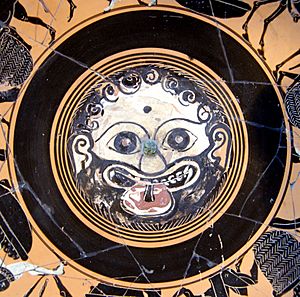
Gorgoneia first appeared in Greek art around the beginning of the 8th century BC. One of the oldest examples was found on a coin during an archaeological dig at Parium. Other early examples from the 8th century BC were found at Tiryns. A similar image from the Knossos palace dates back to the 15th century BC. Some experts even believe the Gorgon image goes back to at least 6000 BC, seen on a ceramic mask from the Sesklo culture.
In the 6th century BC, simple Gorgoneia that looked like "lion masks" were found all over Greek temples, especially near Corinth. Gorgon images were also common on the triangular parts of temple roofs (pediments) in Sicily. The earliest one is probably on the Temple of Apollo in Syracuse. Around 500 BC, they stopped being used on large buildings. However, they were still shown on decorative roof tiles (antefix) of smaller buildings for the next century.
Besides temples, the Gorgon image could be found on clothes, dishes, weapons, and coins. These items were spread across the Mediterranean region, from Etruria (ancient Italy) to the Black Sea coast. The Gorgon's image appeared on coins from 37 different cities. This made her image on coins second only to some of the main Greek gods.
On mosaic floors, the gorgoneion was usually placed near the door, as if it were guarding the entrance. On Attic kilns (ovens for pottery), a gorgoneion above the kiln door was thought to protect against accidents.
The Gorgon image stayed popular even into Christian times, especially in the Byzantine Empire. This included Kievan Rus (an old kingdom in what is now the Ukraine). The image was also used in Western Europe by Italian Renaissance artists. In the 20th century, the gorgoneion was chosen by Gianni Versace as the logo for his fashion company.
Origin of the Gorgoneion
Some researchers believe gorgoneia are part of beliefs about a Mother Goddess. They see it as a symbol of strong life energy. Others suggest that many ancient cultures used similar ritual masks. These masks were meant to scare people from doing wrong, or to make an ugly face at them.
Gallery
-
The marble Medusa Rondanini.
-
Gorgon Medusa (130 AD) from the Romano-Germanic Museum in Cologne.
-
A Roman floor mosaic from Palencia.
See also
Images for kids
-
The Winged Gorgoneion from Olympia (early sixth century BC). It was originally a protective shield decoration.
-
Tomb of the Gorgoneion in the Monterozzi necropolis in Tarquinia, Italy.
See also
 In Spanish: Gorgona para niños
In Spanish: Gorgona para niños



